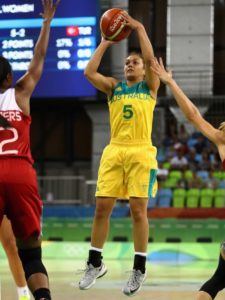Shooting is universally regarded as the “master skill” and the search for better ways to impact the way our young players shoot the ball is a never ending quest for coaches at all levels. So what are some simple ways that youth coaches can play a role in improving this crucial skill area?
De-mystify shooting –
There are endless methods and systems in the market to teach, refine and improve shooting. From specialised shooting coaches, to “can’t fail” coaching aids right down to simple mantras such as “BEEF” (balance, eyes, elbow, follow through) that coaches have been using for years. And no question everyone has good intentions and genuinely wants to have a positive impact on the way young players shoot the ball.
But all this can become “white noise” and often young, aspirational players will watch, read and listen to every piece of jargon and teaching points that the information in their head can’t be navigated and permeates in confusion.
At the Basketball Australia Centre of Excellence, the men’s program spend a lot of time teaching and drilling shooting, but it is all underpinned by these three simple steps –
- Clear your mind and enjoy shooting
- Have a simple plan
- Repetition
Obviously in the daily training environment, there is an opportunity to spend a significant amount of time in developing shooting, but this three-step process underpins the process and all athletes develop their own plan with support from the coaches.
At the Under 10 and 12 level, something as simple as telling the players to shoot “high and soft” can be effective way to give athletes the freedom to shoot and learn through discovery. Endless jargon and complex teaching cues are not always the way to go in helping young players develop a joy for shooting.

Repetition is king –
As with developing any fine motor skill, repetition is so important in developing shooters. This will include instilling a passion in young players to shoot on their own, without a coach, seeing the ball go through the net often.
In the practice setting at the youth level, roughly 30 per cent of total practice time should be devoted to shooting and finishing. With the increased prevalence of the 3-point shot, as a rule we have not generally increased the amount of time we teach and drill shooting. In a 90-minute session, 30% equates to some 33 minutes on the master skill each session leaving an hour to work on small-sided games, technical and tactical.
And of course shooting can be woven into your small-sided games and decision making settings. The key is ensuring each player leaves every practice having shot the ball and developed an understanding of how and when to shoot each shot.
Fix one thing at a time –
As coaches, we all want to help the players as much as possible. There can be a tendency to want to help “too much” and with shooting, this can create confusion. In his recent tour and clinics in Australia, renowned shooting coach Dave Love spoke about isolating one aspect of the shot and working on that, without clouding by trying to “fix” three of four different aspects.
By honing in on one area, coaches can help players build confidence and gain improvement, rather than slow that progress by trying to impact hand position, footwork and release all at the same time.
Guided learning –
Engage the learner (player) in the process. Ask questions such as “how did that feel?” to encourage self-coaching. Even aspects such as where you stand to teach and correct can make a difference. Consider standing next to the shooter at times when teaching, rather than in front, so you see what they see.
Provide them cues to self coach and correct “on the run”. A simple cue can be –
- Rim – what part of the rim did it hit in a miss?
- Reason – why do you think that happened?
- Remedy – what can you change?
Make it fun, show you enjoy teaching it –
At every level, joy is the foundation of skill. Even elite NBA shooters enjoy the quiet time working on their shot, watching the ball go through the net and striving to improve year after year.
For youth players, it is crucial coaches build a real love for shooting and just as importantly, demonstrate that they enjoy teaching it. Being creative, researching and introducing new drills can pay a key role in impacting the way young players approach shooting. If a coach demonstrates a visible passion about shooting, the players will follow suit.




Leave a Reply